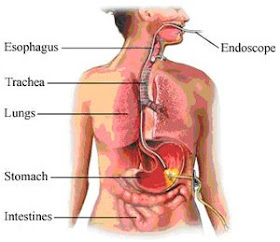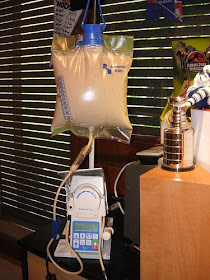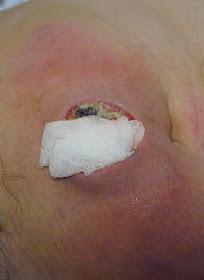The ins and outs of PEG (Percutaneous Endoscopic Gastrostomy) and NG (nasogastric) feeding tubes...
So, what are NG and PEG feeding tubes?
They are medical devices used to provide nutrition to those who cannot obtain nutrition by swallowing. Feeding tubes are often a last resort for chronic anorexics.
An NG tube is passed through the nose, down the esophagus and into the stomach, and a PEG tube is inserted through a small incision in the abdomen into the stomach.
This video shows the NG insertion technique:
PEG tube insertion has a high risk of serious complications. Placement of PEG tubes requires an invasive surgical procedure, and is usually done by a surgeon and a gastroenterologist working together.

The surgeon inserts a needle into the stomach at the spot where the PEG tube will be located. Using the endoscope, the gastroenterologist locates the end of the needle inside the body, and encircles it with a wire snare. A thin wire is then passed from the outside of the body, through this needle and into the abdomen. This wire is then grasped with the snare and pulled out through the mouth. Now, there is a thin wire entering the front of the abdomen into the stomach and continuing upward and out the mouth. The PEG feeding tube is attached to this wire outside of the mouth. The surgeon then pulls the wire back out from the abdomen, which pulls the PEG down into the body through the mouth and esophagus. The tube is pulled until the tip of the PEG comes out of the incision in the stomach. There is a soft, round "bumper" attached to the portion of the PEG that remains inside the body, this bumper secures the tube on the inside of the body. The outer portion of the tube is secured with a bumper as well. Sterile gauze is placed around the incision site and the PEG tube is secured to your abdomen with tape."

Feeding tube system
(1) migration of the tube out of the stomach
(2) necrotizing fasciitis (“flesh eating disease”). Mortality rates for those with necrotizing fasciitis are as high as 73 percent

Necrotizing fasciitis of the abdomen
(3) fluid overload which causes an increase in weight, swelling in the legs and arms, and/or fluid in the abdomen, and breathing difficulties
(4) aspiration pneumonia (caused by inhaling food, liquids, vomit, or secretions from the mout) into the lungs, which can lead to an inflammatory reaction, a lung infection (pneumonia), or a collection of pus in the lungs (lung abscess)
(5) peritonitis, an inflammation of the thin membrane lining, called the peritoneum, that covers the intestinal tract and surrounds the organs in the stomach
(6) abdominal abscess, an infected pocket of fluid and pus located inside the abdominal cavity

Abdominal abscess
(7) bowel obstructions, which prevent the normal transit of the products of digestion. A bowel obstruction is a medical emergency
(8) gastric perforation, a complete penetration of the wall of the stomach, small intestine or large bowel, resulting in intestinal contents flowing into the abdominal cavity
(9) Gastrointestinal bleeding, which is any bleeding that starts in the gastrointestinal tract, which extends from the mouth to the large bowel. GI bleeding can be life threatening
(10) pain at the tube site
(11) tube malfunction
(12) stenosis of the opening (abnormal narrowing)
(13) local bleeding
(14) skin excoriation (traumatized or abraded skin caused by rubbing)

(15) wound dehiscence (the premature "bursting" open of a wound)
(16) cellulitis (diffuse infection of connective tissue with severe inflammation of dermal and subcutaneous layers of the skin)

Abdominal cellulitis
(17) gastroesophageal reflux, which occurs when the lower esophageal sphincter (LES) opens spontaneously, or does not close properly and stomach contents rise up into the esophagus
(18) diarrhea, and
(19) nausea
Feeding tubes do not come without the possibility of serious medical problems. If you are anorexic and presently on a feeding tube, please notify your doctor if you are feeling any discomfort whatsoever. It could save your life.
Links:
http://en.wikipedia.org/wiki/Feeding_tube
http://www.mda.org.au/PEG/peg.asp
http://flickr.com/photos/11374644@N06/2110312729
http://www.ispub.com/ostia/index.php?xmlFilePath=journals/ijps/vol2n2/abdominal.xml
http://pennacademicassociate.com/img/Slideshow/2.JPG
http://www.suile.com/casestudies/index.html
http://www.mrsanotes.com/cellulitis-general-information/


Thanks for this- a lot of people "glorify" having an NG/PEG tube, as it's taken to be a "symbol" of having severe anorexia nervosa. I've had an NG tube for two months at one point, and it IS NOT FUN. Tube-feeding at night (to avoid daytime hassles if the machine starts beeping, and to reduce anxiety about the liquids going in) keeps you up and makes you pee like a racehorse- except guess what? You have to DRAG a flippin' IV pole into the bathroom with you, so let's hope you can hold it 'til you get to the toilet. You have to clean out the tube multiple times during the day, get x-rays to make sure it was properly placed, etc etc etc! And trust me, it's DEFINITELY NOT FUN when you get it placed. No, it doesn't hurt...usually! You might just get "lucky" and have some sinus blockage like I did, resulting in pushing and prodding and gagging to get it down.
ReplyDeleteYeah...Not. Fun.
Lily Jane, thanks so much for taking the time to comment and for sharing your experience.
ReplyDeleteHugs,
Medusa
xoxo
I'am currently on a peg tube for the 2nd time in 10 years.I have to say it really sucks.This time has been much more difficult.I had alot of things go wrong during procedure.Ended up in the hospital for 4 days and experienced alot of pain, let alone weakness.If I could encourage anyone to not end up where I'm at I surely would.To me this is not a fun way to have to live your life unfortunately it was my only way that I probably had a chance of surviving.
ReplyDeleteI've never had an ED, and found your blog by accident but it has been hauntingly informative. I wanted to add some context to your description of cellulitis. I recently got out of the Marines, and cellulitis was a big problem at bootcamp. They were constantly warning us about it, but we would often try to hide injuries since it could set us a month or more back in training which was illogically terrifying for us. So every night before lights out we would have to be checked over in our underwear by our DIs. Even then about a quarter to half of recruits had it at some point or another.
ReplyDeleteIt was painful, disgusting, often swelled, could be lengthy (I'm talking weeks or months on antibiotics, trips to medical, incisions, draining, shots, fevers, etc) to cure, and sometimes life threatening. Sometimes if there was a rash of cases then every recruit who wasn't allergic would get a penicillin/antibiotic shot as a preventative. That was the result of only relatively mild cases since recruits typically developed it from minor abrasions on their arms, legs, or feet (the more covered and hard to clean the more likely you would get it.)
Occasionally the infection would spread to other areas, and so people would get very sick and need length hospitalization. One good friend of mine was in the Navy, and developed cellulitis at one of his courses. It developed into a blood infection, caused a dangerously high fever, and required a spinal tap (which is extremely painful), he almost died, and spent weeks in the hospital. He probably would have died if he hadn't been married because his wife was the one who noticed he wasn't acting very lucid and took him to the ER.
I've never had an ED, and found your blog by accident but it has been hauntingly informative. I wanted to add some context to your description of cellulitis. I recently got out of the Marines, and cellulitis was a big problem at bootcamp. They were constantly warning us about it, but we would often try to hide injuries since it could set us a month or more back in training which was illogically terrifying for us. So every night before lights out we would have to be checked over in our underwear by our DIs. Even then about a quarter to half of recruits had it at some point or another.
It was painful, disgusting, often swelled, could be lengthy (I'm talking weeks or months on antibiotics, trips to medical, incisions, draining, shots, fevers, etc) to cure, and sometimes life threatening. Sometimes if there was a rash of cases then every recruit who wasn't allergic would get a penicillin/antibiotic shot as a preventative. That was the result of only relatively mild cases since recruits typically developed it from minor abrasions on their arms, legs, or feet (the more covered and hard to clean the more likely you would get it.)
Occasionally the infection would spread to other areas, and so people would get very sick and need length hospitalization. One good friend of mine was in the Navy, and developed cellulitis at one of his courses. It developed into a blood infection, caused a dangerously high fever, and required a spinal tap (which is extremely painful), he almost died, and spent weeks in the hospital. He probably would have died if he hadn't been married because his wife was the one who noticed he wasn't acting very lucid and took him to the ER.
Now, the information I'm sharing is all from my experiences in the military. We are all young, physically fit, and have a ridiculously thorough level of medical screening before we were even allowed to apply for enlistment. Most if not all the cellulitis cases happened as a result of infection of superficial abrasions. So if it is that painful, debilitating, and dangerous for us then imagine how much more horrible it would be for a person suffering from an ED? Your low BMI and nutritional deficiencies guarantee a moderate if not severe immunocompromised state.
Your low BMI and nutritional deficiencies guarantee a moderate if not severe immunocompromised state. Add into the fact that these won't be infections from superficial abrasions, but are from complicated incisions deep into your abdomen, and entering the gut. Before antibiotics any incision to the gastrointestinal tract was universally fatal, and even now it can be hit or miss (the death rate for a ruptured appendix in healthy adults is still appallingly high.) I received mid-level combat first aid training, and the only technique we really had for gastrointestinal perforations was to mess with as little as possible, keep the wound covered, and get the patient to a no kidding trauma hospital ASAP. The cut itself is an easy fix, but the real issue are all the nasty little germs that have been set loose into the abdominal cavity. So a patient would be put on an immediate heavy round of antibiotics, but if it wasn't administered quick enough then they would either die of infection or something along the lines of toxic shock syndrome. This is of course in a young, healthy, and physically fit adult. A person suffering from an ED will have next to none of the immunological defenses that are necessary to survive an incident such as this.
ReplyDeleteThis will of course be done in a hospital which have the highest levels of drug resistant MRSA, Streptococcus type A (flesh eating bacteria), Ecoli O157 (the kind that is most likely to kill you), drug resistant respiratory ailments such as the flu, and all sorts of other nasty things out to kill you. So, please listen to M's warnings! This isn't a game of Chicken that you're likely to win. Even if you do survive you could be left with: extensive and grotesque scarring, severely weakened or removed abdominal muscles, permanently damage internal organs (toxic complications can destroy the liver and kidneys and thus leave you on dialysis for the rest of your life), a partially or almost fully removed gastrointestinal tract (which means limited puree meals for the rest of your life, and only being able to use the bathroom via an external colostomy bag), etc.
M, Karen, and Lily Jane I really admire the courage and tenacity you've all shown in your struggles. For me the most frightening and intractable demons are often the ones lurking within your own thoughts.
Thanks,
Ann
aren't these for people who get caught? or are idiots and don't know when to stop dieting. I may be anorexic, but I know when to stop. Nobody thinks skeletons look pretty ><
ReplyDeleteSeriously, marceline? Its not a diet. Its not about getting caught. And by defination, anorexic don't know when to stop or when they have gone too far. As a person who has had both ng for over years and picc lines, I can tell you its not because I was caught. Its because I was dying and had no choice. I don't know who diagnosed you...but you sound more egotistical and historonic then anything...you obviously know nothing about an eating disorder.
ReplyDelete